 The PNC Financial Services Group, Inc. Barclays Global Financial Services Conference September 10, 2012 Exhibit 99.1 |
 2 Cautionary Statement Regarding Forward-Looking Information and Adjusted Information This presentation includes “snapshot” information about PNC used by way of illustration. It is not intended as a full business or financial review and should be viewed in the context of all of the information made available by PNC in its SEC filings. The presentation also contains forward-looking statements regarding our outlook for earnings, revenues, expenses, capital levels and ratios, liquidity levels, asset levels, asset quality, financial position, and other matters regarding or affecting PNC and its future business and operations. Forward-looking statements are necessarily subject to numerous assumptions, risks and uncertainties, which change over time. The forward-looking statements in this presentation are qualified by the factors affecting forward-looking statements identified in the more detailed Cautionary Statement included in the Appendix, which is included in the version of the presentation materials posted on our corporate website at www.pnc.com/investorevents. We provide greater detail regarding these as well as other factors in our 2011 Form 10-K, as amended by Amendment No. 1 thereto, and 2012 Form 10-Qs, including in the Risk Factors and Risk Management sections and in the Legal Proceedings and Commitments and Guarantees Notes of the Notes to Consolidated Financial Statements in those reports, and in our subsequent SEC filings. Our forward-looking statements may also be subject to other risks and uncertainties, including those we may discuss in this presentation or in SEC filings, accessible on the SEC’s website at www.sec.gov and on PNC’s corporate website at www.pnc.com/secfilings. We have included web addresses in this presentation as inactive textual references only. Information on these websites is not part of this presentation. Future events or circumstances may change our outlook and may also affect the nature of the assumptions, risks and uncertainties to which our forward-looking statements are subject. Forward-looking statements in this presentation speak only as of the date of this presentation. We do not assume any duty and do not undertake to update those statements. Actual results or future events could differ, possibly materially, from those anticipated in forward-looking statements, as well as from historical performance. In this presentation, we sometimes refer to adjusted results to help illustrate the impact of certain types of items, such as provisions for residential mortgage repurchase obligations, non-cash charges related to redemptions of trust preferred securities, expenses for residential mortgage foreclosure-related matters, legal, regulatory and OREO costs, and integration costs. This information supplements our results as reported in accordance with GAAP and should not be viewed in isolation from, or as a substitute for, our GAAP results. We believe that this additional information and the reconciliations we provide may be useful to investors, analysts, regulators and others as they evaluate the impact of these respective items on our results for the periods presented due to the extent to which the items may not be indicative of our ongoing operations. We may also provide information on pretax pre-provision earnings (total revenue less noninterest expense) and on tangible book value per share (calculated as book value per share less total intangible assets, other than servicing rights, per share). We believe that pretax pre-provision earnings, a non-GAAP measure, is useful as a tool to help evaluate the ability to provide for credit costs through operations. And we believe that tangible book value per share, a non- GAAP measure, is useful as a tool to help to better evaluate growth of the company’s business apart from the amount, on a per share basis, of intangible assets other than servicing rights included in book value. Where applicable, we provide GAAP reconciliations for such additional information, including in the Appendix and/or other slides and materials on our corporate website at www.pnc.com/investorevents. In certain discussions, we may also provide information on yields and margins for all interest-earning assets calculated using net interest income on a taxable-equivalent basis by increasing the interest income earned on tax-exempt assets to make it fully equivalent to interest income earned on taxable investments. We believe this adjustment may be useful when comparing yields and margins for all earning assets. We may also use annualized, proforma, estimated or third party numbers for illustrative or comparative purposes only. These may not reflect actual results. This presentation may also include discussion of other non-GAAP financial measures, which, to the extent not so qualified therein or in the Appendix, is qualified by GAAP reconciliation information available on our corporate website at www.pnc.com under “About PNC–Investor Relations.” |
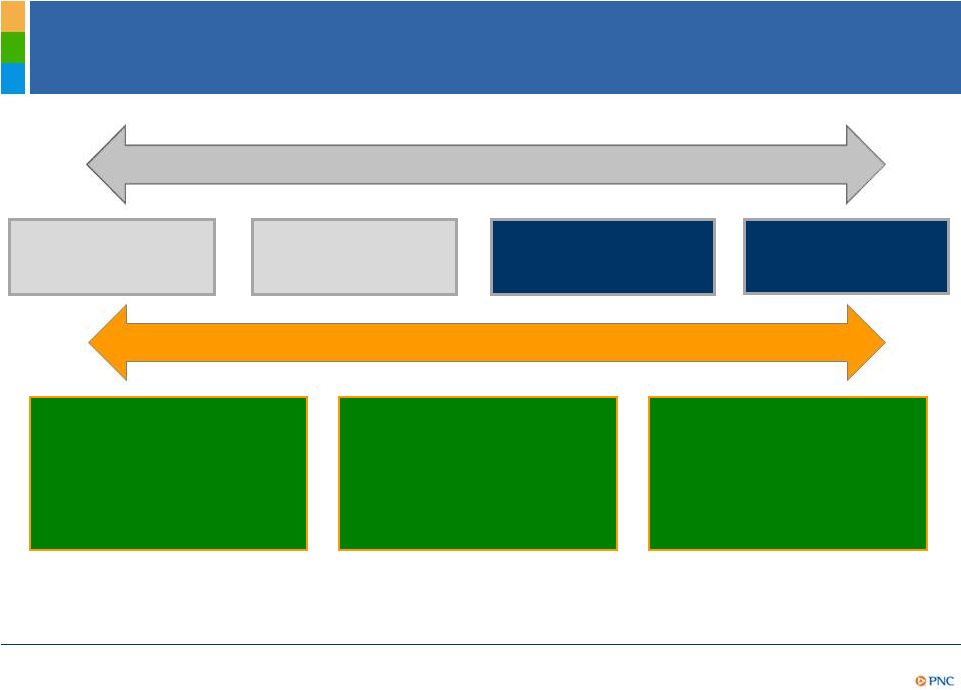 DRAFT 3 Navigating The Current Environment Revenue growth Mortgage- related issues Manage risks and capital Global economy Control costs while investing for growth Regulatory change Grow customers and quality revenues Industry challenges PNC’s priorities |
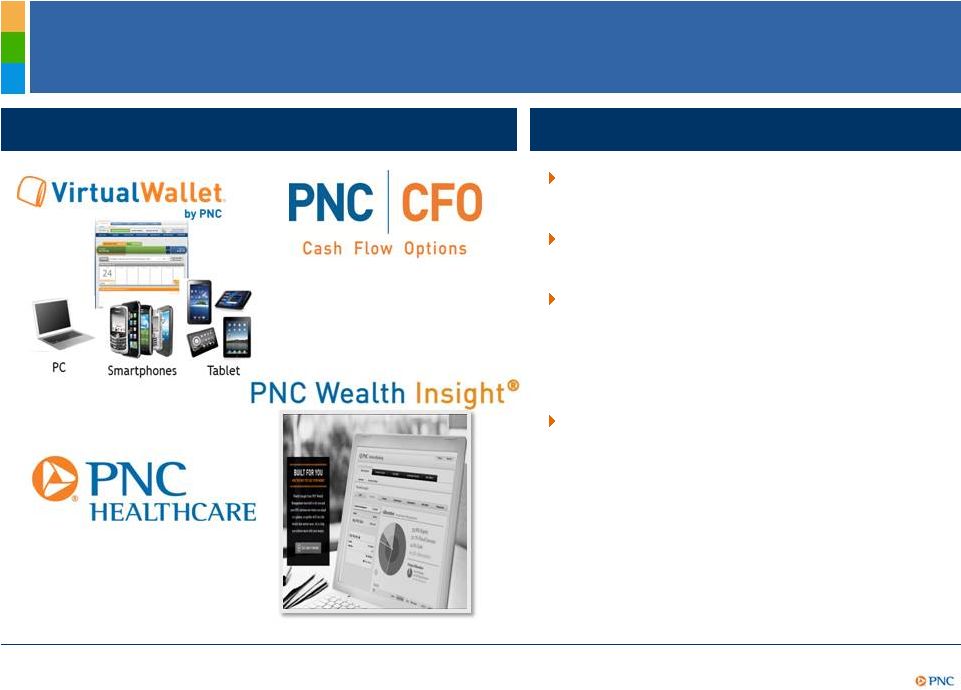 DRAFT 4 Launching New Products That Enhance Customer Experience Investing in technology across all customer segments Product innovation driving customer growth PNC’s customer service differentiation: – Information organized based on how customers think – Integrated experience Giving customers choice Driven by product innovation Future service delivery model SM |
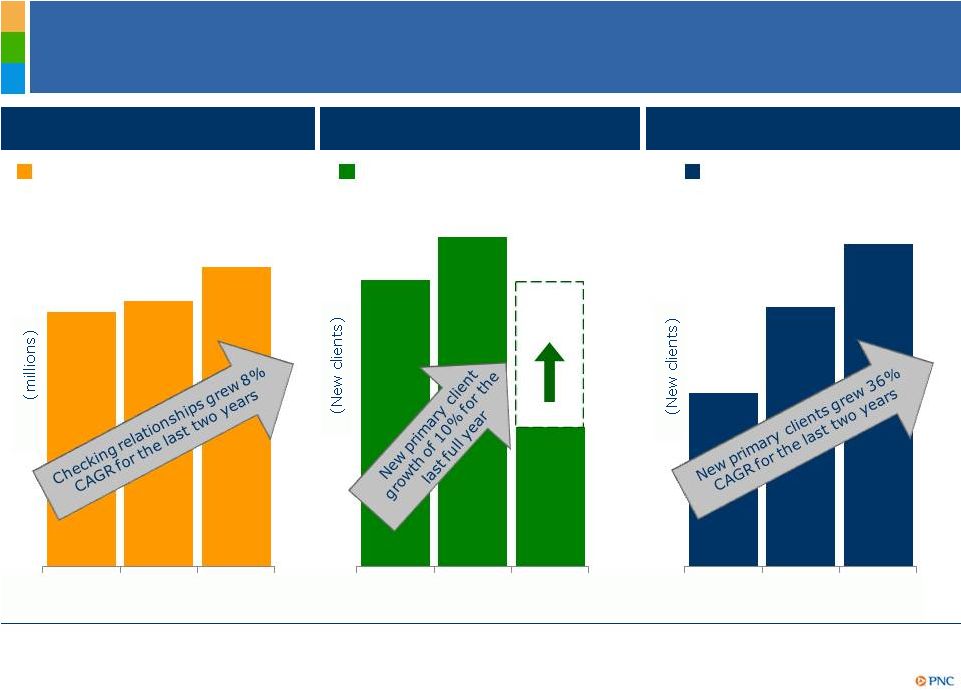 DRAFT Growing Customers – Long-Term Revenue Potential Retail Banking Corporate Banking new primary clients Total checking relationships Asset Management Group New primary clients (for the period indicated) (for the period indicated) (at period end) 5.4 5.6 6.3 2Q10 2Q11 2Q12 1,012 1,165 492 FY10 FY11 1H12 467 696 866 1H10 1H11 1H12 (1) Total checking relationships refers to consumer and small business accounts including 460,000 relationships acquired from RBC Bank (USA) in March 2012, 9,000 relationships acquired from the Flagstar branch acquisition in December 2011, and 32,000 relationships acquired from the BankAtlantic branch acquisition in June 2011. (2) A Corporate Banking primary client is defined as a corporate banking relationship with annual revenue generation of $50,000 or more or, within corporate banking, a commercial banking client relationship with annual revenue generation of $10,000 or more. (3) Asset Management Group primary client is defined as a client relationship with annual revenue generation of $10,000 or more. Corporate & Institutional Banking 1 2 3 5 |
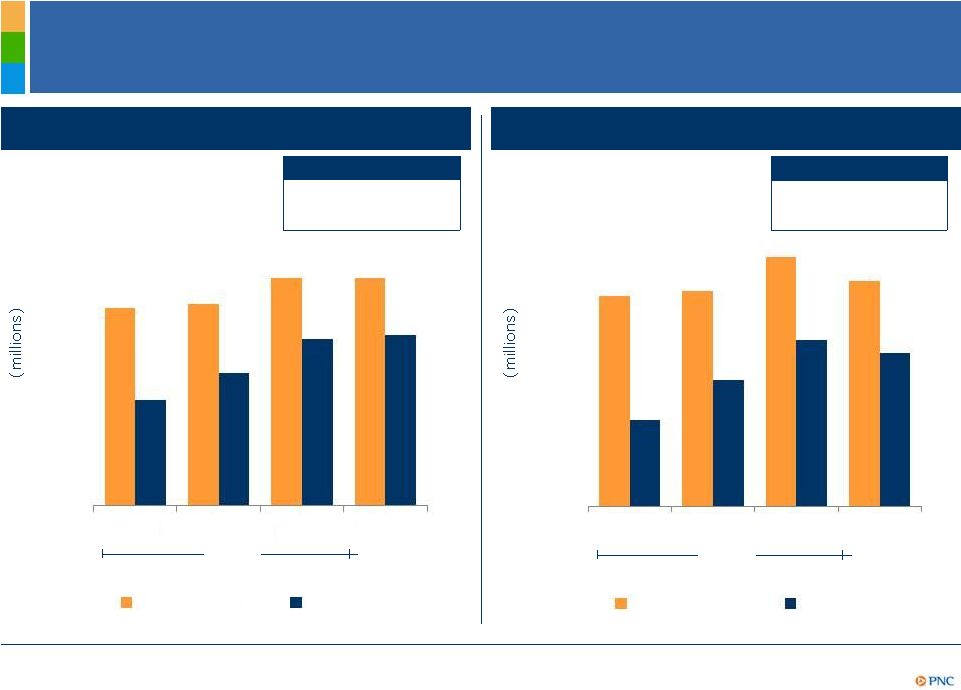 DRAFT 6 Our Sales Momentum is Strong Total Corporate Banking and AMG sales Total Corporate Banking and AMG cross-sell Actual Annualized Actual Annualized 3-year CAGR Northeast 5% Midwest 17% AMG refers to Asset Management Group. (1) Annualized. 3-year CAGR Northeast 2% Midwest 20% 1 1 $0 $100 $200 $300 $400 $500 $600 2009 2010 2011 2012 Northeast Midwest $50 $100 $150 $200 $250 $300 2009 2010 2011 2012 Northeast Midwest $0 |
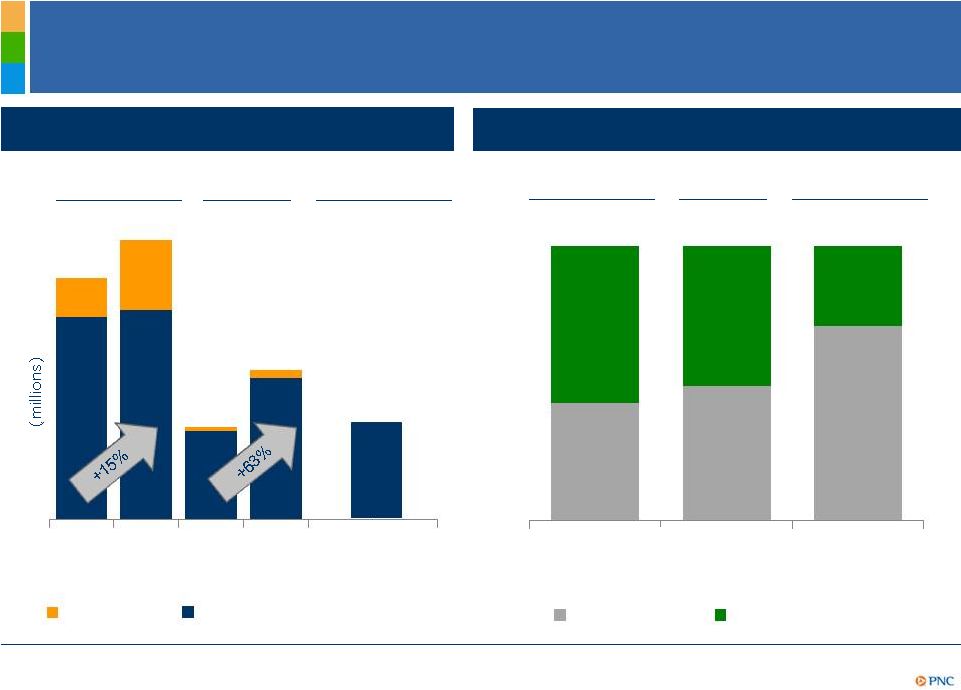 DRAFT 7 Philadelphia 3 AMG refers to Asset Management Group. (1) 2010 vs. 2012 annualized total market sales. (2) RBC markets defined as Eastern Carolina, Western Carolina, Greater Georgia, Northern Alabama and Gulf Coast. AMG sales not yet significant to RBC markets as we are in the build-out phase. (3) For the first half 2012. (4) 12-month annualized sales calculated based on April-July 2012 sales. (5) 12-month annualized. Expanding the Successful PNC Model in Underpenetrated Markets Philadelphia 1 Chicago 1 $xx $105 $121 $40 $65 AMG sales Corporate Banking sales RBC markets 2 Chicago 3 Total Corporate Banking and AMG sales Corporate Banking cross-sell sales by type YTD12 $42 RBC markets 2 Apr-Jul 2012 2010 2012 5 2010 2012 5 2012 4 43% 49% 71% 57% 51% 29% Non-Credit Sales Credit Sales 1 2 3 1 3 2 |
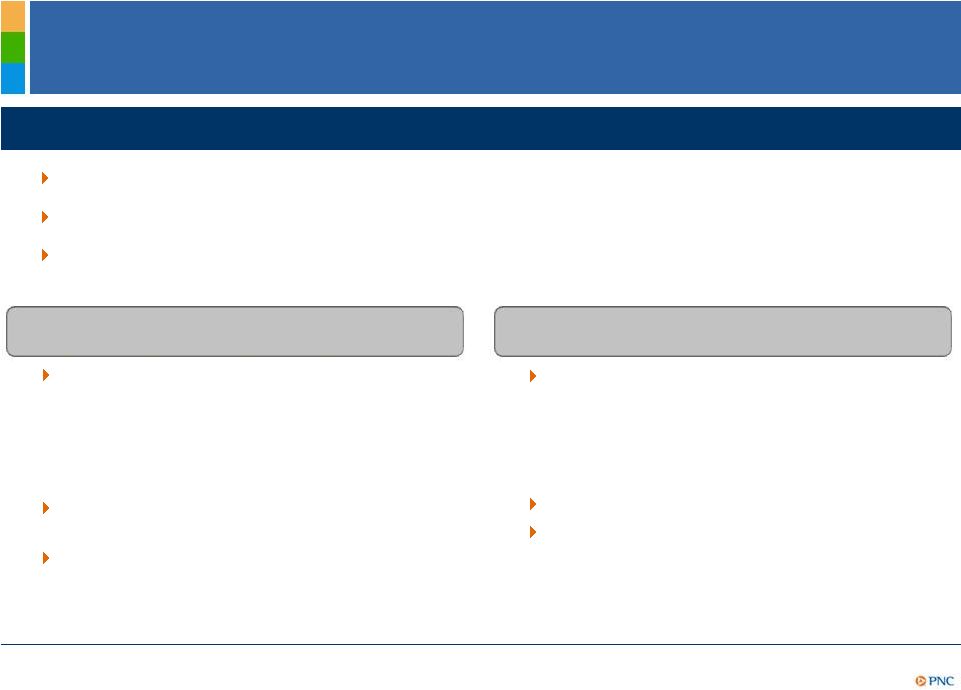 DRAFT 8 Key Retail Revenue Strategies Overall revenue strategies Opportunities to reduce cost to serve in existing traditional branch network Optimize branches and increase customer loyalty Examples – Pittsburgh, Cleveland markets Grow select customer segments Broaden revenue opportunities by expanding our share of customers’ wallets Rethink our delivery network by creating a customer experience that improves customer loyalty and our business margins Secular trends in targeted segments provide opportunity to grow using fewer branches and more technology Invest in multi-channel experiences Applies in growth markets; such as: Traditional branch network Fewer branches/more technology – Migrate branch transactions to image-enabled ATMs – Mobile deposit – PNC advantages – brand, non-branch sales, differentiated offers – Southeast, e.g. Atlanta – Midwest, e.g. Chicago |
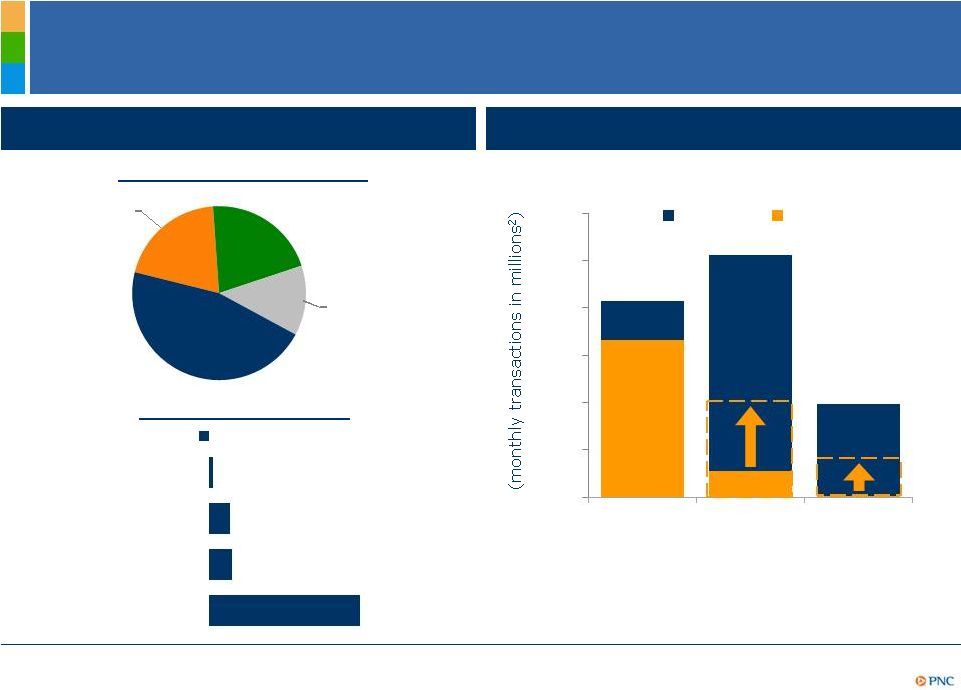 DRAFT 9 Improving Customer Experience, Loyalty and Margins ATM channel migration strategy PNC’s customers changing preferences Withdrawals Deposits Check cashing 40% potential 20% potential Transaction behavior mix 1 Cost per transaction High online 13% 0 2 4 6 8 10 12 Teller ATM Traditional Branch 20% Virtual 21% Multi- channel 46% $3.97 $0.59 $0.56 $0.10 Branch ATM Online/ Mobile Call center - Interactive voice response Consumer (1) Percentages reflect the proportion of PNC customers considered to be traditional branch, virtual, high online usage or multi-channel customers based upon channel utilized for transactions. Transactions refer to service transactions which include deposits, withdrawals and payments. Traditional branch customer is a customer who conducts greater than 80% of monthly transactions in a branch. Virtual customer is a customer who conducts the majority of monthly transactions at non-branch channels (i.e., ATM, Online, Call Center, Mobile). High online usage customer is a customer with 10 or more monthly of the following: online sessions, transfers, online bill pays and two or fewer branch transactions. Multi-channel customer is a customer who uses all the channels including branch but is not dominant in any. (2) Monthly transactions reflect the monthly average for transactions conducted from October 2010-November 2011. |
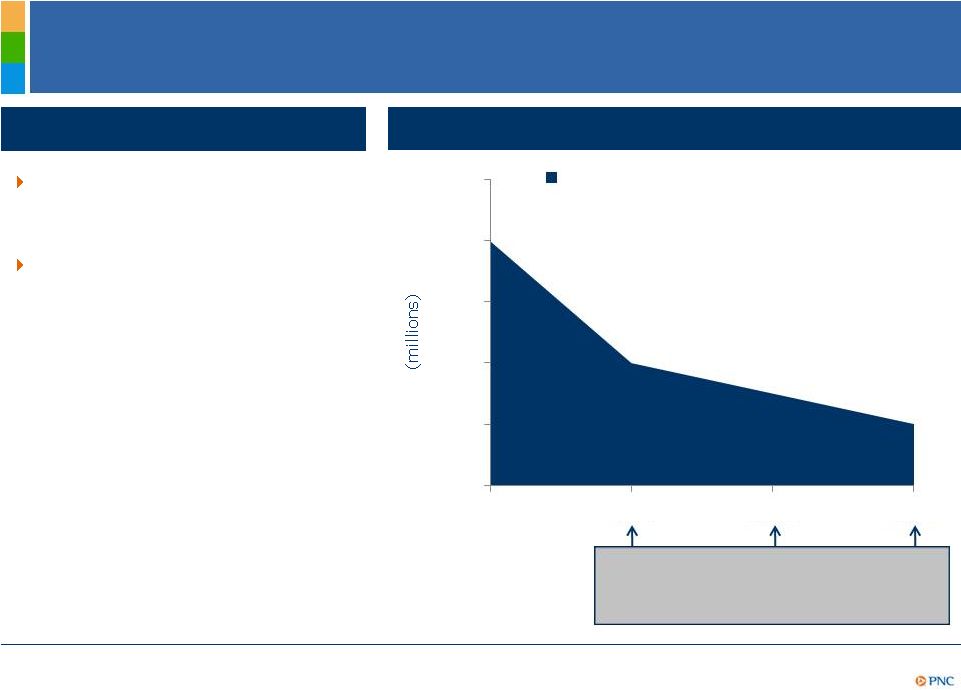 DRAFT 10 Revenue Potential Should Exceed Decline in Purchase Accounting Accretion Total revenue in 2013 expected to increase when compared to 2012 Core NII 2 and noninterest income growth expected to exceed the purchase accounting decline of approximately $400 million Purchase accounting accretion decline 2013 highlights (1) Refer to Cautionary Statement in the Appendix, including assumptions. (2) Core NII is total net interest income less purchase accounting accretion. $400 $200 $100 $0 $100 $200 $300 $400 $500 2013 2014 2015 2016 Expected year over year decline in purchase accounting accretion PAA decline in 2014 is less than 1.5% of total revenue and declining going forward 1 1 $150 |
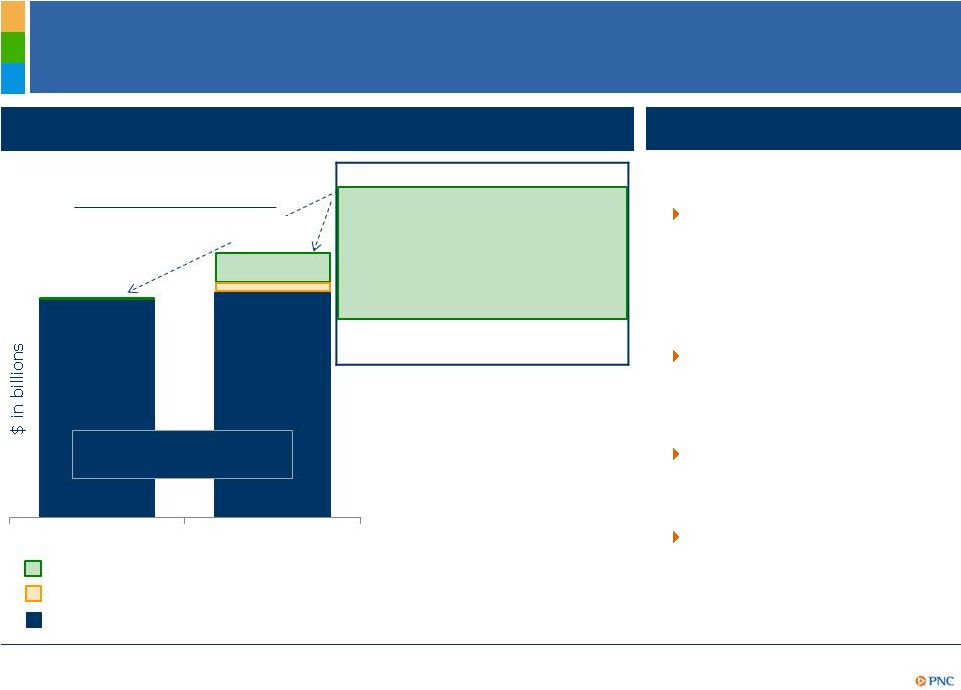 DRAFT 11 Disciplined Expense Management While Investing For Growth Highlights Noninterest expense overview Continuous improvement: Select costs All other noninterest expense RBC Bank (USA) operating costs 2012 continuous improvement initiatives target of $400 million 4 has resulted in a financial impact of $186 million in 1H12 Continuous improvement cost saves expected to provide capacity for over 90% of 2012 investments Goal of CIP is to provide the capacity to invest in future growth RBC Bank (USA) integration cost saves of $150 million remain on track Components of Noninterest Expense 1 1 1H11 1H12 Legal/mortgage foreclosure-related/ OREO costs³ 2% 6% Integration costs 0% 4% TPS redemption charges 0% 2% % of noninterest expense 2% 12% $4.2 $5.1 All other noninterest expense relatively flat 1H11 1H12 2 $4.2 $4.3 (1) Further information is provided in the Appendix. (2) Select costs include legal/mortgage foreclosure/OREO costs, integration costs and trust preferred securities redemption charges. (3) Legal represents accruals for legal contingencies and mortgage foreclosure represents costs to comply with regulatory consent decrees. OREO costs consist of gains/losses on sale of OREO assets, write-downs on the assets and operating expenses. (4) Continuous improvement initiatives related to legacy PNC’s operational and business efficiency initiatives with an estimated 2012 impact of $400 million, which is part of the total CIP 2012 goal of $550 million. |
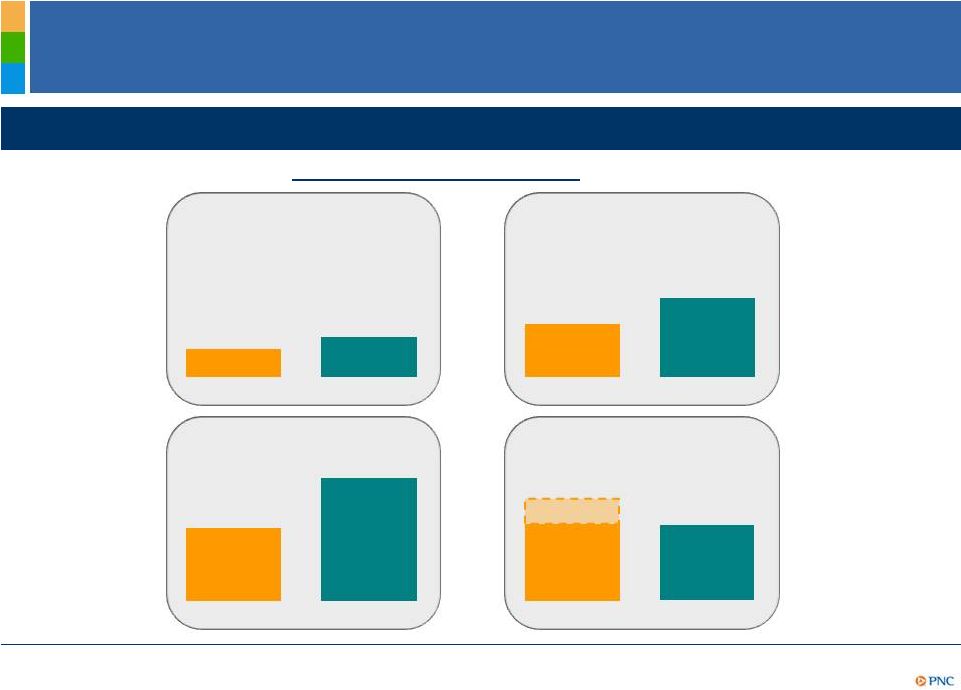 DRAFT 12 Effectively Managing Credit Risk 2Q12 credit risk metrics PNC Peers Strong credit performance 0.71% 1.03% PNC Peers 1.92% 3.26% PNC Peers 1.39% 2.09% PNC Peers 2.30% 2.26% 3.06% 4 Net charge-offs to average loans Nonperforming assets 2 to total assets Nonperforming loans 2 to total loans Loan loss reserves 3 to total loans (1) Reflects company data for 2Q12 as of quarter-end except net charge-offs, which are for the quarter and annualized, and average loans, which are for the quarter. Peer source: SNL database. Peers reflects the average of the peers listed in the Appendix. (2) Nonperforming loans exclude certain government insured or guaranteed loans, loans held for sale, loans accounted for under the fair value option and purchased impaired loans. (3) The allowance for loan and leases losses includes impairment reserves attributable to purchased impaired loans. (4) 2Q12 reserves/loans for PNC would have been 3.06% if both reserves and loans had been adjusted to include the remaining marks on purchased impaired loans. Further information is provided in the Appendix. Other peers have made acquisitions and have marks on purchased impaired loans; however, no adjustments have been made for those peers. 1 |
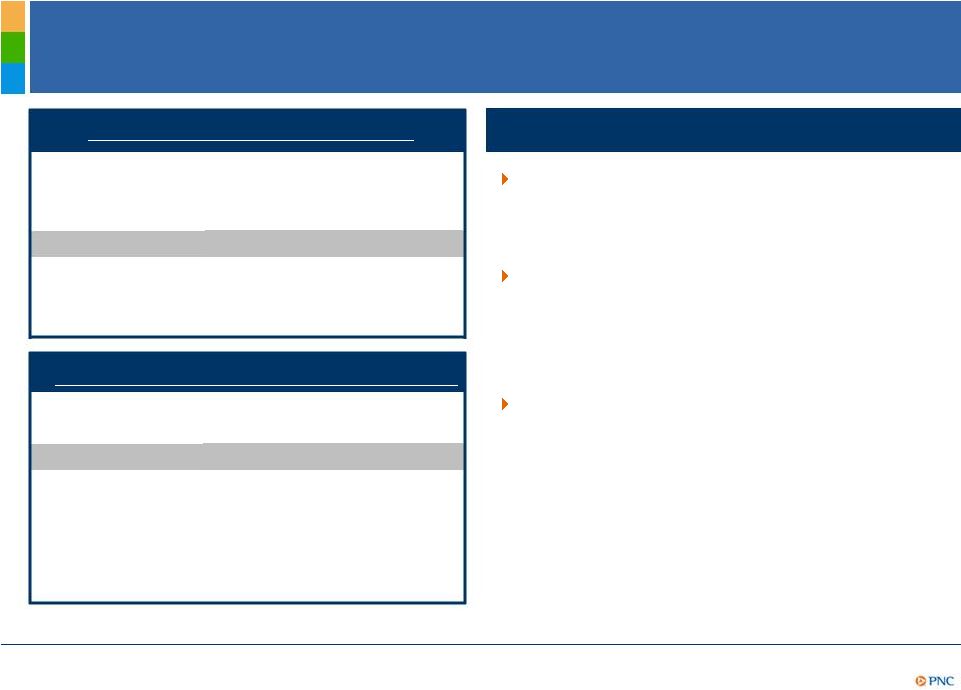 DRAFT 13 Reserves for Residential Mortgage Repurchase Demands 1 Reflect Expected Lifetime Losses Elevated levels of residential mortgage repurchase demands and the change in behaviors of the GSE’s are issues impacting the entire industry PNC added provision of approximately $438 million to residential mortgage repurchase reserves in 2Q12 based on expected lifetime losses of $1.7 billion 1,3 which includes $1.2 billion of losses incurred to date Relative to the companies listed in the table, PNC’s reserve levels to outstanding demands and loss coverage ratio are strong Highlights Reserves to outstanding demands USB 132% WFC 100 JPM 94 PNC 92 FITB 78 BAC 70 STI 67 Five Quarter Average Loss coverage ratio BAC 14.3x JPM 9.9 PNC 9.4 C 8.2 USB 6.7 WFC 5.3 STI 3.7 FITB 3.6 2 2 (1) Does not include home equity loans for PNC. (2) Reserves refer to reserves for indemnification and repurchase liability for asserted and unasserted claims with respect to residential mortgages sold. Source: company reports. As of June 30, 2012. (3) Barring significant changes in the future behaviors and demand patterns of investors/guarantors or other unforeseen circumstances, we believe we are appropriately reserved against future demands with respect to the sold residential mortgage portfolio at June 30, 2012. Members of our peer group for which these categories of information was publicly available, plus Citigroup, are presented. |
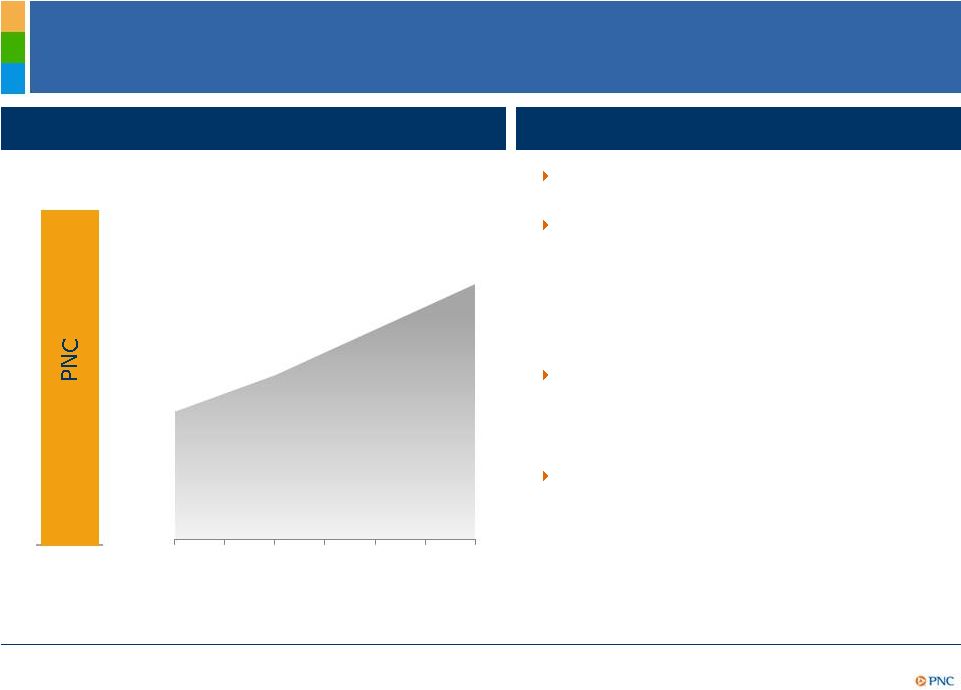 DRAFT 14 Strong Capital and Liquidity Position (1) Regulatory requirements are inclusive of the capital conservation buffer and subject to further regulatory guidance and clarity on Basel NPRs. (2) Based on Basel III NPRs and including application of Basel II (as modified by NPRs) and Basel II.5 rules. (3) Parent company liquidity coverage defined as liquid assets divided by funding obligations within a two year period. 2Q12 highlights Basel I Tier 1 common ratio of 9.3% at June 30, 2012 Capital priorities: – Build capital to support client growth and business investment – Maintain appropriate capital in light of economic uncertainty – Return excess capital to shareholders Basel III Tier 1 common ratio goal of 8.0-8.5% by year-end 2013 without benefit of phase-ins² Strong liquidity position – Loans to deposits ratio of 87% – Parent company two year liquidity coverage³ of 117% Basel III Tier 1 common ratio Basel III requirements 8.0% - 8.5% 2013 Goal Basel III 3.5% 4.0% 4.5% 5.1% 5.8% 6.4% 7.0% 2013 2014 2015 2016 2017 2018 2019 1 – Improved capital treatment expected on sub-investment grade securities |
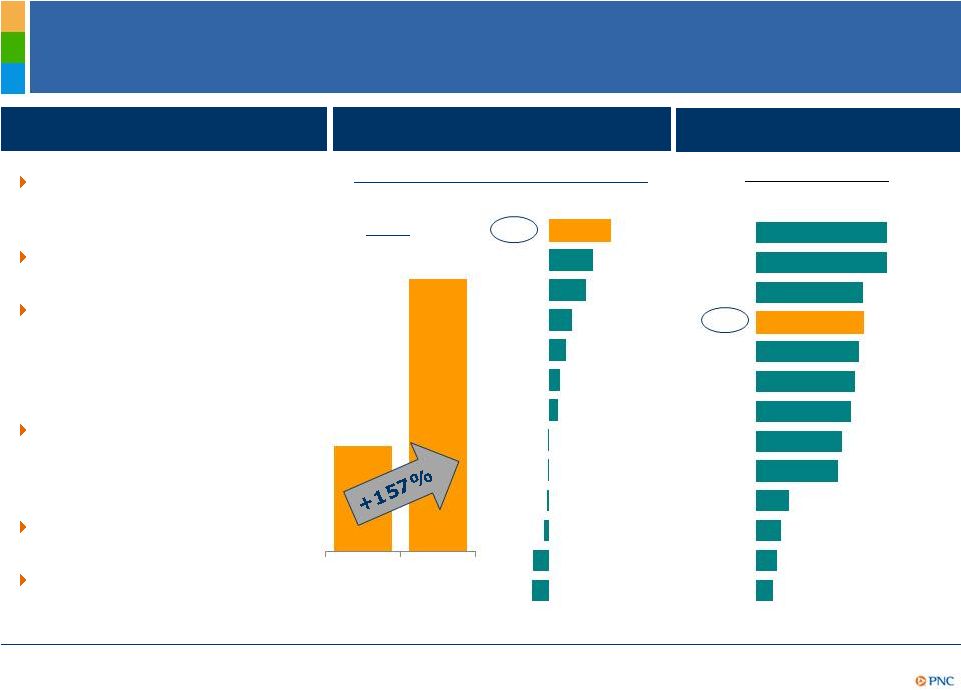 DRAFT 15 Executing Our Business Model has Delivered Value CMA BAC FITB STI RF KEY $17.58 $45.19 PNC Staying core funded and disciplined in our deposit pricing Committed to our moderate risk philosophy Leveraging customer relationships and our strong brand to grow high quality, diverse revenue streams Focused on creating positive operating leverage while investing in innovation Remaining disciplined with our capital Executing on our strategies PNC’s successful business model Annualized dividend yield % change 12/31/2007 to 6/30/2012 As of 8/31/2012 12/31/07 6/30/12 157% 112% 94% 59% 45% 28% 25% -1% -2% -3% -12% -39% -42% PNC WFC USB JPM MTB COF BBT 3.2% 3.2% 2.6% 2.6% 2.5% 2.4% 2.3% 2.1% 2.0% 0.8% 0.6% 0.5% 0.4% MTB JPM WFC PNC BBT KEY USB FITB CMA STI RF BAC COF 2 1 Tangible book value per share Peer Source: SNL DataSource. (1) Tangible book value per share calculated as book value per share less goodwill and certain other intangible assets. Further information is provided in the Appendix. (2) Dividend yield calculated as the annualized dividend divided by the closing stock price. |
 DRAFT 16 Cautionary Statement Regarding Forward-Looking Information Appendix This presentation includes “snapshot” information about PNC used by way of illustration and is not intended as a full business or financial review. It should not be viewed in isolation but rather in the context of all of the information made available by PNC in its SEC filings. We also make statements in this presentation, and we may from time to time make other statements, regarding our outlook for earnings, revenues, expenses, capital levels and ratios, liquidity levels, asset levels, asset quality, financial position, and other matters regarding or affecting PNC and its future business and operations that are forward-looking statements within the meaning of the Private Securities Litigation Reform Act. Forward-looking statements are typically identified by words such as “believe,” “plan,” “expect,” “anticipate,” “see,” “look,” “intend,” “outlook,” “project,” “forecast,” “estimate,” “goal,” “will,” “should” and other similar words and expressions. Forward- looking statements are subject to numerous assumptions, risks and uncertainties, which change over time. Forward-looking statements speak only as of the date made. We do not assume any duty and do not undertake to update forward-looking statements. Actual results or future events could differ, possibly materially, from those anticipated in forward-looking statements, as well as from historical performance. Our forward-looking statements are subject to the following principal risks and uncertainties. •Our businesses, financial results and balance sheet values are affected by business and economic conditions, including the following: o Changes in interest rates and valuations in debt, equity and other financial markets. o Disruptions in the liquidity and other functioning of U.S. and global financial markets. o The impact on financial markets and the economy of any changes in the credit ratings of U.S. Treasury obligations and other U.S. government-backed debt, as well as issues surrounding the level of U.S. and European government debt and concerns regarding the creditworthiness of certain sovereign governments, supranationals and financial institutions in Europe. o Actions by Federal Reserve, U.S. Treasury and other government agencies, including those that impact money supply and market interest rates. o Changes in customers’, suppliers’ and other counterparties’ performance and creditworthiness. o Slowing or failure of the current moderate economic expansion. o Continued effects of aftermath of recessionary conditions and uneven spread of positive impacts of recovery on the economy and our counterparties, including adverse impacts on levels of unemployment, loan utilization rates, delinquencies, defaults and counterparty ability to meet credit and other obligations. o Changes in customer preferences and behavior, whether due to changing business and economic conditions, legislative and regulatory initiatives, or other factors. •Our forward-looking financial statements are subject to the risk that economic and financial market conditions will be substantially different than we are currently expecting. These statements are based on our current view that the moderate economic expansion will persist in 2012 and interest rates will remain very low. |
 DRAFT 17 Cautionary Statement Regarding Forward-Looking Information (continued) Appendix • Legal and regulatory developments could have an impact on our ability to operate our businesses, financial condition, results of operations, competitive position, reputation, or pursuit of attractive acquisition opportunities. Reputational impacts could affect matters such as business generation and retention, liquidity, funding, and ability to attract and retain management. These developments could include: o Changes resulting from legislative and regulatory reforms, including major reform of the regulatory oversight structure of the financial services industry and changes to laws and regulations involving tax, pension, bankruptcy, consumer protection, and other industry aspects, and changes in accounting policies and principles. We will be impacted by extensive reforms provided for in the Dodd-Frank Wall Street Reform and Consumer Protection Act (the “Dodd-Frank Act”) and otherwise growing out of the recent financial crisis, the precise nature, extent and timing of which, and their impact on us, remains uncertain. o Changes to regulations governing bank capital and liquidity standards, including due to the Dodd-Frank Act and to Basel-related initiatives. o Unfavorable resolution of legal proceedings or other claims and regulatory and other governmental investigations or other inquiries. In addition to matters relating to PNC’s business and activities, such matters may include proceedings, claims, investigations, or inquiries relating to pre-acquisition business and activities of acquired companies, such as National City. These matters may result in monetary judgments or settlements or other remedies, including fines, penalties, restitution or alterations in our business practices and in additional expenses and collateral costs, and may cause reputational harm to PNC. o Results of the regulatory examination and supervision process, including our failure to satisfy requirements of agreements with governmental agencies. o Impact on business and operating results of any costs associated with obtaining rights in intellectual property claimed by others and of adequacy of our intellectual property protection in general. • Business and operating results are affected by our ability to identify and effectively manage risks inherent in our businesses, including, where appropriate, through effective use of third-party insurance, derivatives, and capital management techniques, and to meet evolving regulatory capital standards. In particular, our results currently depend on our ability to manage elevated levels of impaired assets. • Business and operating results also include impacts relating to our equity interest in BlackRock, Inc. and rely to a significant extent on information provided to us by BlackRock. Risks and uncertainties that could affect BlackRock are discussed in more detail by BlackRock in its SEC filings. • Our acquisition of RBC Bank (USA) presents us with risks and uncertainties related to the integration of the acquired businesses into PNC, including: o Anticipated benefits of the transaction, including cost savings and strategic gains, may be significantly harder or take longer to achieve than expected or may not be achieved in their entirety as a result of unexpected factors or events. o Our ability to achieve anticipated results from this transaction is dependent also on the extent of credit losses in the acquired loan portfolios and the extent of deposit attrition, in part related to the state of economic and financial markets. Also, litigation and regulatory and other governmental investigations that may be filed or commenced relating to the pre-acquisition business and activities of RBC Bank (USA) could impact the timing or realization of anticipated benefits to PNC. o Integration of RBC Bank (USA)’s business and operations into PNC may take longer than anticipated or be substantially more costly than anticipated or have unanticipated adverse results relating to RBC Bank (USA)’s or PNC’s existing businesses. PNC’s ability to integrate RBC Bank (USA) successfully may be adversely affected by the fact that this transaction results in PNC entering several geographic markets where PNC did not previously have any meaningful retail presence. |
 DRAFT 18 Cautionary Statement Regarding Forward-Looking Information (continued) Appendix •In addition to the RBC Bank (USA) transaction, we grow our business in part by acquiring from time to time other financial services companies, financial services assets and related deposits and other liabilities. These other acquisitions often present risks and uncertainties analogous to those presented by the RBC Bank (USA) transaction. Acquisition risks include those presented by the nature of the business acquired as well as risks and uncertainties related to the acquisition transactions themselves, regulatory issues, and the integration of the acquired businesses into PNC after closing. •Competition can have an impact on customer acquisition, growth and retention and on credit spreads and product pricing, which can affect market share, deposits and revenues. Industry restructuring in the current environment could also impact our business and financial performance through changes in counterparty creditworthiness and performance and in the competitive and regulatory landscape. Our ability to anticipate and respond to technological changes can also impact our ability to respond to customer needs and meet competitive demands. •Business and operating results can also be affected by widespread disasters, dislocations, terrorist activities or international hostilities through impacts on the economy and financial markets generally or on us or our counterparties specifically. We provide greater detail regarding these as well as other factors in our 2011 Form 10-K, as amended by Amendment No. 1 thereto, and first and second quarter 2012 Form 10-Qs, including in the Risk Factors and Risk Management sections and the Legal Proceedings and Commitments and Guarantees Notes of the Notes to Consolidated Financial Statements in those reports, and in our subsequent SEC filings. Our forward-looking statements may also be subject to other risks and uncertainties, including those we may discuss elsewhere in this presentation or in SEC filings, accessible on the SEC’s website at www.sec.gov and on our corporate website at www.pnc.com/secfilings. We have included these web addresses as inactive textual references only. Information on these websites is not part of this document. Any annualized, proforma, estimated, third party or consensus numbers in this presentation are used for illustrative or comparative purposes only and may not reflect actual results. Any consensus earnings estimates are calculated based on the earnings projections made by analysts who cover that company. The analysts’ opinions, estimates or forecasts (and therefore the consensus earnings estimates) are theirs alone, are not those of PNC or its management, and may not reflect PNC’s or other company’s actual or anticipated results. |
 DRAFT 19 Non-GAAP to GAAP Reconcilement Appendix In millions except per share data Dec. 31, 2007 Jun. 30, 2012 % Change Common shareholders' equity $14,847 $33,884 Common shares outstanding 341 529 Book value per common share $43.60 $64.00 47% Goodwill and other intangible assets other than servicing rights $8,853 $9,981 Common shareholders' equity less intangible assets $5,994 $23,903 Common shares outstanding 341 529 Tangible book value per common share $17.58 $45.19 157% As of As of In millions June 30, 2012 Allowance for loan and lease losses $4,156 Remaining mark on purchased impaired loans $1,400 Allowance for loan and lease losses, adjusted to include remaining mark $5,556 Loans, as reported $180,425 Loans, adjusted to include remaining mark on purchased impaired loans $181,825 Allowance for loan and lease losses to loans 2.30% Allowance for loan and lease losses plus remaining mark to loans plus remaining mark 3.06% In millions Jun. 30, 2012 Jun. 30, 2011 % Change Total revenue, as reported 7,355 7,233 2% Provision for residential mortgage repurchase obligation 470 35 Total revenue, as adjusted $7,825 $7,268 8% For the six months ended |
 DRAFT 20 Non-GAAP to GAAP Reconcilement Appendix In millions Jun. 30, 2012 Jun. 30, 2011 Legal/regulatory/OREO costs 283 74 Integration costs 197 6 TPS redemption-related charges 130 - RBC Bank (USA) operating costs 189 - All other 4,304 4,166 Total noninterest expense $5,103 $4,246 For the six months ended |
 DRAFT 21 Peer Group of Banks Appendix The PNC Financial Services Group, Inc. PNC BB&T Corporation BBT Bank of America Corporation BAC Capital One Financial, Inc. COF Comerica Inc. CMA Fifth Third Bancorp FITB JPMorgan Chase JPM KeyCorp KEY M&T Bank MTB Regions Financial Corporation RF SunTrust Banks, Inc. STI U.S. Bancorp USB Wells Fargo & Co. WFC Ticker |